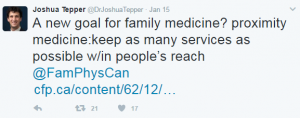Médecine de proximité

“The goal of proximity medicine is to keep as many services as possible within people’s reach.”
Dr. Marie-Dominique Beaulieu, former President of the College of Family Physicians of Canada, presented a compelling vision for Family Medicine at the Dr. Ian McWhinney Lecture last September. Entitled “The perils and the promise of proximity,” Dr. Bealieu issues a sincere wake-up call to family doctors, to move “beyond our current understanding of patient-centered care into the realm of partnerships with patients, wherever they are in their lives or communities.”
“Medicine is coming up against a wall.”
Proximity medicine is not simply geographic access – it is a medical approach “that can take into consideration individuals in their entirety and in their complexity, support them in their journey, and place them at the heart of the health care system.” Dr. Beaulieu laments that “technological developments are distancing us from the knowledge, skills, and know-how we need to cope with the challenges facing us.”
The Four Challenges:
1. action on the social determinants of health;
2. timely access to care;
3. care transitions and service integration; and
4. overdiagnosis and overtreatment—our practice of maximally intrusive medicine.
1. Social determinants of health
“We are not all born equal”
Family physicians need to take specific actions aimed at social determinants and by adopting non-stigmatizing practices. This can be accomplished by applying for income supplements, advocating for change in our communities, supporting resources and fostering social participation. Most importantly, ensuring all services are accessible to all our patients, regardless of their sociodemographic characteristics.
2. Accessibility
“We have built fortified castles around our clinics”
Dr. Beaulieu notes that to many, “the concept of service quality referred primarily to whether practices conformed to guidelines rather than to comprehensiveness, timely access, or continuity of care.” To the contrary, timely access to care is not a luxury, but a necessity – or as she writes, “one of the pillars of the patient’s Medical Home.”
3. Care transitions
“The hospital is part of the community and needs to build bridges with services and professionals outside its walls… How do we persuade hospitals to be part of the proximity medicine community?”
“Fragmentation of care is a scourge, one of the primary causes of gaps in care and medical errors.” Care transitions, whether from home to hospital or hospital to home, need to be seamless.
4. Overdiagnosis and overtreatment: “maximally disruptive medicine.”
“Being a patient has become a full-time job”
Dr. Beaulieu laments that over-testing and over-diagnosis have plunged medicine and society into “a vortex from which we cannot extract ourselves without a drastic change in culture.”
“We offer people increasingly complex treatment plans. We interfere with their work, their leisure, and their lives overall. “
The cure: parsimonious medicine not personalized medicine. Evidence-based approaches that propose interventions that offer real differences for patients. “We need a medicine that truly involves patients as full partners in their own diagnoses and care, which is what proximity medicine is all about. We need darn good clinicians.” Medicine based on “sound clinical judgment…medicine that tolerates uncertainty.”
In the end, I agree with Dr. Josh Tepper, CEO and President of Health Quality Ontario:

Can Fam Physician. 2016 Dec; 62(12): 964–968.

